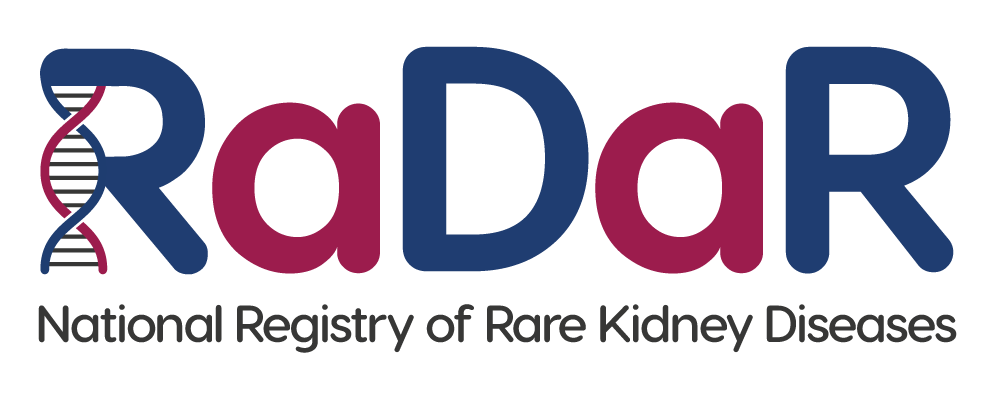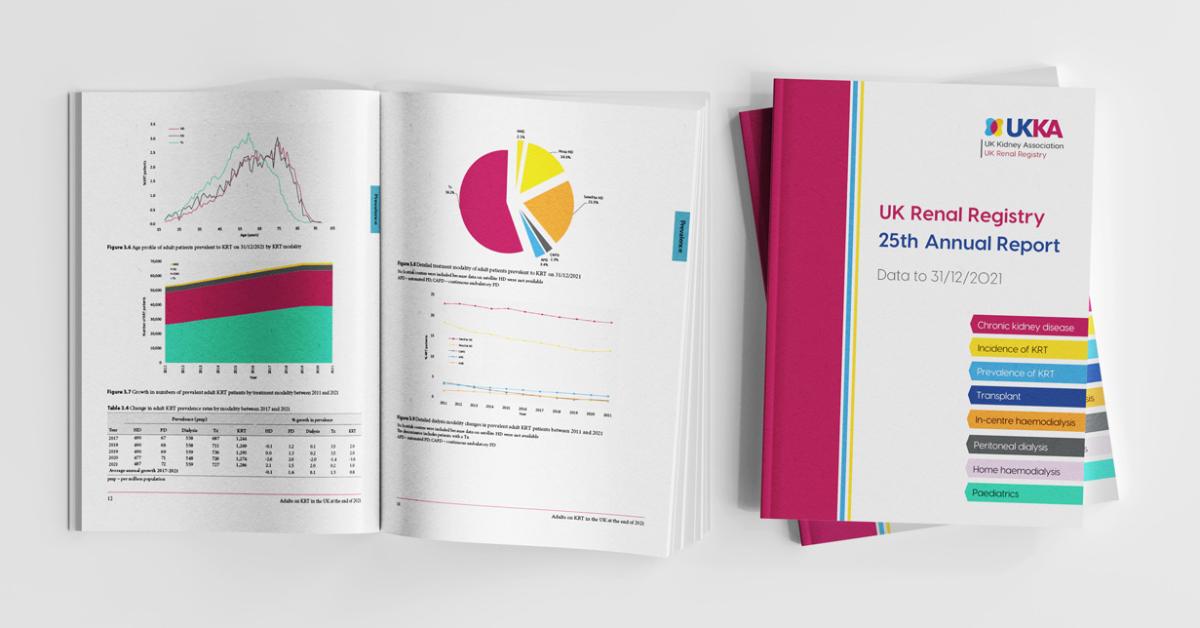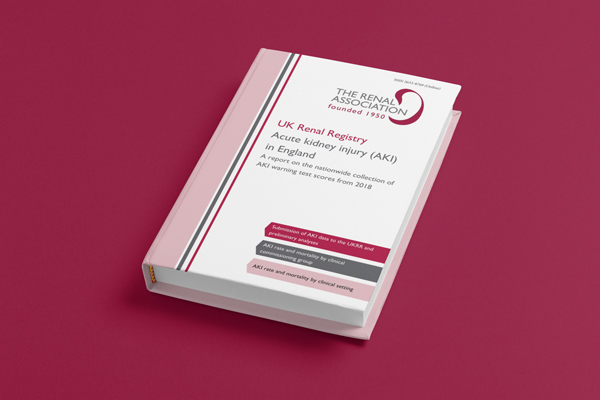Clinician Information
This page focuses on the diagnosis and management of Alport Syndrome in a UK context. Other high quality, detailed resources are linked at the bottom of the page.
About 40 per million, including carriers.
Alport Syndrome accounts for about 1% of patients on renal replacement therapy (RRT) in the UK, 438 in 2010. There is probably a similar or larger number of patients destined to reach end stage renal failure.
In X-linked Alport syndrome, two carrier females are born for each affected male. In autosomal recessive disease the incidence of carriers is much higher, possibly as high as 1 in 100, but much less is known about their prognosis. There are therefore probably at least 2000 carriers that have not yet been identified. 300-600 of these (15-30%) may get significant renal disease in their lifetime (see Carriers below).
So on average, per million population there are around 45 Alport patients, of whom:
- 7 will be on RRT
- 7-10 are destined to need RRT one day
- 30 are carriers with a need to understand the implications for their family, and because some of them are at substantially increased risk of Alport-related renal failure during their lifetime.
These estimates may rise as genetic testing and epidemiological studies reveal milder or different phenotypes.
Renal: Many patients with Alport syndrome and some carriers have episodes of macroscopic haematuria in infancy, with persistent microscopic haematuria. Albuminuria develops, followed by overt proteinuria, which can reach nephrotic levels. Later, GFR falls progressively. Hypertension is not usually an early feature. Some carriers show similar, usually slower progression.
Deafness tends to become a problem during the proteinuric phase (and therefore before GFR loss) but there is quite wide variation. It is exceptional for patients with severe renal disease to have normal hearing, except that in carriers there is greater variation.
RRT: The median age of commencing dialysis in X-linked Alport’s is 34 years.
Schooling: A minority develop renal failure at school age, but increasing deafness at secondary school is quite common.
AR disease: Autosomal recessive disease affects males and females equally, and in recent studies appears to follow a similar rate of progression as is seen in males with XL Alport’s.
Genotype-phenotype: There is a correlation with genotype in males with X-linked disease in that severe mutations such as gene deletions and truncating mutations are associated with earlier onset of deafness and renal failure. No such correlation is seen in females.
UK resources for genetics and other tests
Biopsy – light microscopy has no strongly suggestive features, only electron microscopy changes are specific. If the classic basement membrane changes are associated with an Alport phenotype the diagnosis is certain. To confirm the diagnosis in another family member renal biopsy can again be useful, though genetic tests are now an alternative for many. When there is no conclusive genetic result, a renal biopsy remains the best test but it needs to be undertaken in a patient or affected relative with quite well preserved glomerular structure, so good kidney function.
Detection of antigen in skin is theoretically valuable but less useful practically, and this test is not routinely available in the UK. Type IV collagen a5/a6 trimers are found in skin, so both chains may be absent from skin in patients with COL4A5 deletions or mutations causing incomplete chain formation. However the immunohistopathological studies are technically demanding and often less conclusive or helpful than you’d hope. Patients with absent antigen in skin tend to have earlier disease onset and often a more obvious diagnosis than others anyway. Genetic testing is usually positive in such patients and is becoming simpler and more reliable.
Detection of antigen in glomeruli is more reliable than skin studies, but the glomeruli have to be in reasonable shape for the appearances to be conclusive. As with skin, total absence of antigen (you expect all three chains of the 3-4-5 heterotrimer to be absent) is not universal, only reliably found with gene deletions and truncating mutations which can usually be identified by genetic testing.
Genetic testing is now the test of choice in patients with probable Alport syndrome, wherever it is available and affordable. Knowing the mutation means that cascade testing is simpler and quicker for other family members and it also enables the possibility of pre prenatal diagnosis (PND) and pre-implantation diagnosis (PGD).
In the UK, testing of all three possibly affected genes is undertaken at Guy’s clinical genetics lab, and these tests are recognised in the UK Genetic Testing Network’s directory.
To find out how to send a sample in the UK, contact your local Clinical Geneticist. You can also get further information from the NHS Genomics website
If you send ‘possible’ Alport patient samples for genetic testing, it helps if you can predict the most likely gene to target (COL4A5 if only males are affected in a pedigree; COL4A3/4 if females develop renal failure at a young age or if the parents are consanguineous). Hopefully known pathogenic mutations will be identified, but you may receive reports of sequence variants of ‘possible’ or ‘uncertain’ significance. Testing of all three genes is sometimes required, which is expensive and even then it may not provide definitive confirmation of the diagnosis at a genetic level.
At present, testing is done by Sanger sequencing of exons and exon-intron boundaries, along with techniques to identify gene deletions. This is expensive and genes are analysed serially. Next-generation sequencing techniques, in which multiple genes are sequenced at one time, are being tested now and are soon likely to make multiple testing routine and less expensive.
The proportion of patients with definite or probable causative mutations has been gradually rising so that now 95% of patients with definite Alport syndrome clinically are found to have a causative mutation(s). Increasingly, associations of mutations in different genes are being detected. This is likely to rise further as next-generation sequencing techniques make it standard to sequence multiple genes together.
Give ACE inhibitors if there’s proteinuria, whether patient or a carrier. Kidneys
ACE inhibitors are strongly recommended for all patients with Alport syndrome who have proteinuria. Angiontensin blockers (ARB) are an alternative if ACE inhibitors are not tolerated.
In mice and dogs with Alport mutations, ACE inhibitors slow the rate of loss of GFR and postpone end stage renal failure. Recent observations in a European Alport registry suggest the same in humans. Gross et al (2012) showed a marked difference in the age of developing end stage renal disease in boys with X-linked Alport’s treated with ACE inhibitors versus those who were not. Although this was not a randomised study, there appeared to be greater benefit from starting treatment earlier, alongside supportive evidence from animal experiments, and little apparent risk from the drugs.
This applies to carriers with proteinuria too.
A paediatric randomised control trial is under way to test even earlier commencement of ACE inhibitors, in male infants with only haematuria. The EARLY PRO-TECT Alport phase III clinical trial started recruiting patients in 2012, aiming to test early therapy with Ramipril. It is not (yet) possible to join this study from the UK.
ACE inhibitors have been widely prescribed to patients with proteinuria over the last couple of decades, including many patients with Alport’s. This may explain the shift in the age of onset of ESRF in men with Alport Syndrome from a median of 26.6 years in 1990-4 to 33.7 years in 2005-9.
ACE inhibitors often need to be introduced cautiously, as patients with Alport’s tend to have normal blood pressure at the time they develop proteinuria. The recommendation is to work up to full, or maximally tolerated dose.
Hearing
It is common practice in the UK for pediatricians to screen children’s hearing regularly and this is recommended in the expert guidelines. This leads to identification of hearing loss and prescription of aids, but not to any alteration in the natural history of hearing loss.
Although hearing aids look much better than they used to, older children and young adults are often understandably reluctant to wear them as they mark them out as vulnerable and different. This can affect them socially and educationally.
Eye changes
The proportion of patients with retinal changes increases with time, but these are not vision-threatening. While they may sometimes be of diagnostic value, there isn’t good reason to screen for them. The characteristic changes to the lens and occasionally cornea are typically late, occurring in middle adult life. It is probably not worth looking for them unless there is a problem with vision.
Particular issues in carriers; monitoring recommendations.
95% of female carriers of X-linked Alport syndrome have haematuria by the time they reach adulthood. The proportion of carriers developing significant renal disease in their lifetime is higher than previously thought, possibly as many as 25-30% reaching ESRF by 80 years, but this figure may reflect ascertainment bias and may fall with wider use of ACE inhibitors.
Much less is known about carriers of autosomal recessive disease. The prognosis may be better. Carrier status for autosomal Alport’s accounts for at least some of Thin GBM Nephropathy. It is now difficult to be so confident that the alternative label of ‘benign familial haematuria’ is appropriate.
The risk factors for progression in carriers are not characterised. Proteinuria is the earliest marker of risk and should lead to ACE inhibitors prescription.
ACE inhibition must be interrupted for pregnancy. Whether this should be done in advance of conception or when pregnancy is confirmed is for discussion, and may be influenced by the perceived risk of long periods off ACE inhibitors.
Carriers should be monitored occasionally (e.g. annually), life-long. This need not be at a renal unit, although having them on the books has the advantage that you can find them if new treatments or information come along.
We are keen to register all carriers in the Alport pages of the national UK Rare Kidney Disease Registry (RaDaR).
Value in concentrating patients in one clinic. Befriend your geneticists.
Clinics: It is probably advantageous for Alport patients to attend a common clinic, at least before end stage, so that linkages with geneticists, audiologists etc can develop.
Befriend your geneticists: Relationships with clinical geneticists increasingly need to be more collaborative and not regarded as referrals to a remote unit for one-off advice. Appropriate advice to patients and carriers has changed rapidly, and will continue to do so. The same is true of the role for genetic testing.
Increasingly this makes it attractive for one or a few clinicians to major on genetic conditions. Genetics may quickly become relevant to most or all, but a conduit for discussing changing problems is invaluable.
And Alport anti-GBM disease.
The majority of UK Alport RRT patients are transplanted and do well. The complication of Alport anti-GBM disease is rare but a serious problem for those who get it.
How to contact the UK Alport group
Members of the Alport Rare Disease Group can give advice to UK clinicians. Please contact us through the contact form
Frequently asked questions include:
- Can this carrier be a kidney donor?
- What does this genetic test really mean?
- Could this [phenotype] be Alport, and what’s the best approach to finding out?
- How should we manage this patient with Alport anti-GBM disease?
- Can/how should we re-transplant?
Links to more extensive information.
The Gene Reviews (NCBI Bookshelf) article by Dr Cliff Kashtan on Alport Syndrome and Thin Basement Membrane Nephropathy is comprehensive and excellent.
Expert Guidelines for the Management of Alport Syndrome and Thin Basement Membrane Nephropathy. Judy Savige et al. J Am Soc Nephrol 2013 24:364-75 PMID: 23349312
Early angiotensin-converting enzyme inhibition in Alport syndrome delays renal failure and improves life expectancy. Gross O et al. Kidney Int 2012 Mar; 81(5):494-501 PMID: 22166847
Outcomes of male patients with Alport syndrome undergoing renal replacement therapy. Temme J, Gross O et al. Clin J Am Soc Nephrol 2012 7:1969-76 PMID: 22997344
Genecard on Alport syndrome from Eur J Hum Genetics (open access; quite technical genetic information)
X-linked Alport syndrome: natural history and genotype-phenotype correlations in girls and women belonging to 195 families: a ‘European Community Alport Syndrome Concerted Action’ study. Jais JP, Gubler MC et al . J Am Soc Nephrol. 2003 14:2603-10. PMID: 14514738
OMIM entries: X-linked Alport Autosomal recessive Alport Syndrome




